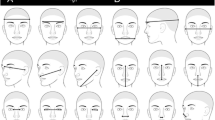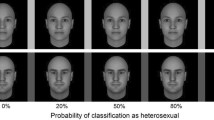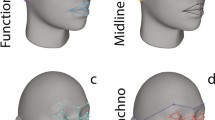Abstract
We used magnetic resonance (MR) images obtained in same-sex and opposite-sex dizygotic twins (n = 119, 8 years of age) to study possible effects of prenatal androgens on craniofacial features. Using a principal component analysis of 19 craniofacial landmarks placed on the MR images, we identified a principal component capturing craniofacial features that distinguished females with a presumed differential exposure to prenatal androgens by virtue of having a male (vs. a female) co-twin (Cohen’s d = 0.76). Subsequently, we tested the possibility that this craniofacial “signature” of prenatal exposure to androgens predicts brain size, a known sexually dimorphic trait. In an independent sample of female adolescents (singletons; n = 462), we found that the facial signature predicts up to 8 % of variance in brain size. These findings are consistent with the organizational effects of androgens on brain development and suggest that the facial signature derived in this study could complement other indirect measures of prenatal exposure to androgens.


Similar content being viewed by others
References
Anblagan D, Jones NW, Costigan C, Parker AJJ, Allcock K, Aleong R, Coyne LH, Deshpande R, Fenning NR, Bugg G, Roberts N, Pausova Z, Paus T, Gowland PA (2013) Maternal smoking during pregnancy and fetal organ growth: a magnetic resonance imaging study. PLoS One 8(6):e67223. doi:10.1371/journal.pone.0067223
Anders Van, Verhon PA (2006) Finger-length ratios show evidence of prenatal hormone transfer between opposite-sex twins. Horm Behav 49:315–319
Avants BB, Epstein CL, Grossman M, Gee JC (2008) Symmetric diffeomorphic image registration with cross-correlation: evaluating automated labeling of elderly and neurodegenerative brain. Med Image Anal 12(1):26–41
Baker JH, Lichtenstein P, Kendler KS (2009) Intrauterine testosterone exposure and risk for disordered eating. Br J Psychiatry 194:375–376
Bartley AJ, Jones DW, Weinberger DR (1997) Genetic variability of human brain size and cortical gyral patterns. Brain 120(2):257–269
Borghammer P, Ostergaard K, Cumming P, Gjedde A, Rodell A, Hall N, Chakravarty MM (2010) A deformation-based morphometry study of patients with early-stage Parkinson’s disease. Eur J Neurol 17(2):314–320
Bulygina E, Mitteroecker P, Aiello L (2006) Ontogeny of facial dimorphism and patterns of individual development within one human population. Am J Phys Anthropol 131:432–443
Chakravarty M, Aleong R, Leonard G, Perron M, Pike B, Richer L, Veillette S, Pausova Z, Paus T (2011) Automated analysis of craniofacial morphology using magnetic resonance images. PLoS One 6(5):e20241. doi:10.1371/journal.pone.0020241
Chen WJ, Maier SE, Parnell SE, West JR (2003) Alcohol and the developing brain: neuroanatomical studies. Alcohol Res Health 27(2):174–180
Chura LR, Lombardo MV, Ashwin E, Auyenung B, Chakrabarti B, Bullmore ET, Cohen SB (2010) Organizational effects of fetal testosterone on human corpus callosum size and asymmetry. Psychoneuroendocrinology 35(1):122–132
Clemens LG, Gladue BA, Coniglio LP (1978) Prenatal endogenous androgenic influences on masculine sexual behavior and genital morphology in male and female rats. Horm Behav 10:40–53
Cohen-Bendahan CCC, Buitelaar JK, van Goozen SMH, Cohen-Kettenis PT (2004) Prenatal exposure to testosterone and functional cerebral lateralization: a study in same-sex and opposite-sex twin girls. Psychoneuroendocrinology 29:911–916
Cohen-Bendahan CCC, van de Beek C, Berenbaum SA (2005) Prenatal sex hormone effects on child and adult sex-typed behavior: methods and findings. Neurosci Biobehav Rev 29:353–384
Collins DL, Holmes CJ, Peters TM, Evans AC (1994) Automatic 3-D model-based neuroanatomical segmentation. Hum Brain Mapp 3(3):190–208
Cootes TF, Taylor CJ (1992) Active shape models – ‘smart snakes’. In: Hogg D, Boyle R (eds) BMVC92. Springer-Verlag, London, pp 266–275
Couly GF, Coltey PM, Le Douarin NM (1993) The triple origin of skull in higher vertebrates: a study in quail-chick chimeras. Development 117:409–429
Dempsey PJ, Townsend GC, Richards LC (1999) Increased crown size in females with twin brothers: evidence for hormonal diffusion between human twins in utero. Am J Hum Biol 11:577–586
Diewert VM, Lozanoff S (1993) A morphometric analysis of human embryonic craniofacial growth in the median plane during primary palate formation. J Craniofac Genet Dev Biol 13:184–192
Diewert VM, Lozanoff S, Choy V (1993) Computer reconstructions of human embryonic craniofacial morphology showing changes in relations between the face and brain during primary palate formation. J Craniofac Genet Dev Biol 13(3):193–201
Even MD, Dhar MG, vom Saal FS (1992) Transport of steroids between fetuses via amniotic fluid in relation to the intrauterin position phenomenon in rats. J Reprod Fertility 96:709–716
Fink B, Grammer K, Mitteroecker P, Gunz P, Schaefer K, Bookstein FL, Manning IT (2005) Second to fourth digit ratio and face shape. Proc R Soc Lond B Biol Sci 272:1995–2000
Frey S, Pandya DN, Chakravarty MM, Bailey L, Petrides M, Cllins L (2011) An MRI based average macaque monkey stereotaxic atlas and space (MNI monkey space). Neuroimage 55(4):1435–1442
Galsworthy MJ, Dionne G, Dale PS, Plomin R (2000) Sex differences in early verbal and non-verbal cognitive development. Dev Sci 3:206–215
Grabner G, Janke AL, Budge MM, Smith D, Pruessner J, Collins DL (2006) Symmetric atlasing and model based segmentation: an application to the hippocampus in older adults. Med Image Comput Comput Assist Interv 9(Pt 2):58–66
Guihard-Costa AM, Khung S, Delbecque K, Menez F, Delezoide AL (2006) Biometry of face and brain in fetuses with trisomy 21. Pediatr Res 59:33–38
Henderson BA, Berenbaum SA (1997) Sex-typed play in opposite-sex twins. Dev Psychobiol 31:115–123
Hönekopp J, Bartholdt L, Beier L, Liebert A (2007) Second to fourth digit length ratio (2D:4D) and adult sex hormone levels: new data and a meta-analytic review. Psychoneuroendocrinology 32(4):313–321
Isaacs EB, Fischl BR, Quinn BT, Chong WK, Gadian DG, Lucas A (2010) Impact of breast milk on IQ, brain size and white matter development. Pediatr Res 67(4):357–362
Kinsley C, Miele J, Konen C, Ghiraldi L, Svare B (1986) Intrauterine contiguity influences regulatory activity in adult female and adultmale-mice. Horm Behav 20:7–12
Knickmeyer RC, Wheelwright S, Taylor K, Raggatt P, Hackett G, Baron-Cohen S (2005) Gender-typed play and amniotic testosterone. Dev Psychol 41:517–528
Kontges G, Lumsden A (1996) Rhombencephalic neural crest segmentation is preserved throughout craniofacial ontogeny. Development 122:3229–3242
Larkby C, Day N (1997) The effects of prenatal alcohol exposure. Alcohol Health Res World 21(3):192–198
Liu F, van der Lijn F, Schurmann C, Zhu G, Chakravarty MM et al (2012) A genome-wide association study identifies five loci influencing facial morphology in europeans. PLoS Genet 8(9):1–13
Lombardo MV, Ashwin E, Auyeung B, Chakrabarti B, Taylor K, Hackett G, Bullmore ET, Baron-Cohen S (2012) Fetal testosterone influences sexually dimorphic gray matter in the human brain. J Neurosci 32(2):674–680
Manning JT, Stewart A, Bundred PE, Trivers RL (2004) Sex and ethnic differences in 2nd to 4th digit ratio of children. Early Hum Dev 80(2):161–168
Manning JT, Churchill JGA, Peters M (2007) The effects of sex, ethnicity, and sexual orientation of sef-measured digit ratio (2D:4D). Arch Sex Behav 36(2):223–233
Marečková K, Weinbrand Z, Chakravarty MM, Lawrence C, Aleong R, Leonard G et al (2011) Testosterone-mediated sex differences in the face shape during adolescence: subjective impressions and objective features. Horm Behav 60(5):681–690
Marečková K, Chakravarty MM, Huang M, Lawrence C, Leonard G, Perron M (2013) Does skull shape mediate the relationship between objective features and subjective impressions about the face? Neuroimage 79:234–240
McIntyre MH (2006) The use of digit ratios as markers for perinatal androgen action. Reprod Biol Endocrinol 4(10). doi:10.1186/1477-7827-4-10
Medland SE, Loehlin JC, Willemsen G, Hatemi PK, Keller MC, Boomsma DI, Eaves LJ, Martin NG (2008) Males do not reduce the fitness of their female cotwins in contemporary samples, Twin Res. Hum Genet 11:481–487
Meindl K, Windhager S, Wallener B, Schaefer K (2012) Second-to-fourth digit ratio and facial shape in boys: the lower the digit ratio, the more robust the face. Proc R Soc B 279(1737):2457–2463
Miller EM (1994) Prenatal sex hormone transfer: a reason to study opposite-sex twins. Personal Individ Differ 17:511–529
Muenke M, Beachy PA (2000) Genetics of ventral forebrain development and holoprosencephaly. Curr Opin Genet Dev 10:262–269
Neave N, Laing S, Fink B, Manning JT (2003) Second to fourth digit ratio, testosterone and perceived male dominance. Proc R Soc Lond B 270:2167–2172
Noden DM (1978) The control of Avian cephalic neural crest cytodifferentiation: skeletal and connective tissues. Dev Bio 96:144–165
Paus T (2010) Sex differences in the human brain: a developmental perspective. Prog Brain Res 186:13–28
Paus T (2013) Population neuroscience. Springer-Verlag, Berlin, Heidelberg, ISBN-10: 3642364497
Paus T, Bernard M, Chakravarty MM, Smith GD, Gillis J, Lourdusamy A, Leonard G, Melka MG, Pavlidis P, Perron M, Pike GB, Richer L, Schumann G, Timpson N, Toro R, Veillette S, Pausova Z (2012) KCTD8 gene and brain growth in adverse intrauterine environment: a genome-wide association study. Cereb Cortex 22:2634–2642
Pausova Z, Paus T, Abrahamowicz M, Almerigi J, Arbour N, Bernard M et al (2007) Genes, maternal smoking, and the offspring brain and body during adolescence: design of the Saguenay Youth Study. Hum Brain Mapp 28:502–518
Peper JS, Brouwer RM, van Baal G, Schnack H, leeuwen M, Boomsma D, Kahn R, Pol H (2009) Does having a twin brother make for a bigger brain? Eur J Endocrinol 160:739–746
Phoenix CH, Goy RW, Gerall AA, Young WC (1959) Organizing action of prenatally administered testosterone propionáte on the tissue mediating mating behavior in the female guinea pig. Endocrinology 65:369–382
Pujol J, Soriano-Mas C, Gispert JD, Bossa M, Reig S, Ortiz H et al (2011) Variation in the shape of the frontobasal brain region in obsessive–compulsive disorder. Hum Brain Mapp 32:1100–1108
Quadagno DM, McQuitty C, McKee J, Koelliker L, Wolfe G, Johnson DC (1987) The effects of intrauterine position on competition and behavior in the mouse. Physiol Behav 41:639–642
Rainey WE, Rehman KS, Carr BR (2004) The human fetal adrenal: making adrenal androgens for placental estrogens. Semin Reprod Med 22:327–336
Ryan BC, Vandenberg JG (2002) Intrauterine position effects. Neurosci Biobehav Rev 26:665–678
Sarkar P, Bergman K, Fisk NM, O’Connor TG, Glover V (2007) Amniotic fluid testosterone: relationship with cortisol and gestational age. Clin Endocrinol (Oxf) 67:743–747
Sibson R (1978) Studies in the robustness of multidimensional scaling: procrustes statistics. J Roy Stat Soc 40:234–238
Sled JG, Zijdenbos AP, Evans AC (1998) A nonparametric method for automatic correction of intensity nonuniformity in MRI data. IEEE Trans Med Imaging 17:87–97
Smith SM (2002) Fast robust automated brain extraction. Hum Brain Mapp 17(3):143–155
Smith SM, De Stefano N, Jenkinson M, Matthews PM (2001) Normalised accurate measurement of longitudinal brain change. J Comput Assist Tomogr 25(3):466–475
Smith SM, Zhang Y, Jenkinson M, Chen J, Matthews PM, Federico A, De Stefano N (2002) Accurate, robust and automated longitudinal and cross-sectional brain change analysis. Neuroimage 17(1):479–489
Smith SM, Jenkinson M, Woolrich MW, Beckmann CF, Behrens TEJ, Johansen-Berg H et al (2004) Advances in functional and structural MR image analysis and implementation as FSL. Neuroimage 23(S1):208–2019
Sperber GH, Sperber SM, Guttmann GD (2000) Craniofacial embryogenetics and development, Shelton, CT: People’s Medical Pub. House, USA
Tapp AL, Maybery MT, Whitehouse AJO (2011) Evaluating the twin testosterone transfer hypothesis: a review of the empirical evidence. Horm Behav 60:713–722
Valla K, Halazonetis DJ (2014) Correlation of 2D:4D digit ratio and craniofacial shape in prepubertal children. Am J Hum Biol 26(3):337–346
Van de Beek C, Thijssen JHH, Cohen-Kettenis PT, van Goozen SHM, Buitelaar JK (2004) Relationships between sex hormones assessed in amniotic fluid, and maternal and umbilical cord serum: what is the best source of information to investigate the effects of fetal hormonal exposure? Horm Behav 46:663–669
vom Saal FS, Bronson FH (1980) Sexual characteristics of adult female mice are correlated with their blood testosterone levels during prenatal development. Science 208:597–599
Voracek M, Dressler SG (2007) Digit ratio (2D:4D) in twins: heritability estimates and evidence for a masculinized trait expression in women from opposite-sexpairs. Psychol Rep 100:115–126
Zhang Y, Brady M, Smith S (2001) Segmentation of brain MR images through a hidden Markov random field model and the expectation maximization algorithm. IEEE Trans Med Imaging 20(1):45–57
Zheng Z, Cohn MJ (2011) Developmental basis of sexually dimorphic digit ratios. Proc Nat Acad Sci 108:16289–16294
Zingeser MR, Phoenix CH (1978) Metric characteristics of the canine dental complex in prenatally androgenized female rhesus monkeys (Macaca mulatta). Am J Phys Anthrop 49:187–192
Acknowledgments
The Saguenay Youth Study was funded by the Canadian Institute of Health Research, Heart and Stroke Foundation of Quebec, and the Canadian Foundation of Innovation. The Quebec Newborn Twin Study was funded by Canadian Institute of Health Research and Fonds de la recherche en santé du Quebec. We would like to thank SciNet for access to its supercomputer platform, which is funded by the Canada Foundation for Innovation, NSERC, the Government of Ontario, FedDev Ontario, and the University of Toronto. Finally, we would also like to thank the European Social Fund and the government of Czech Republic who co-financed the project „Employment of Newly Graduated Doctors of Science for Scientific Excellence (grant number CZ.1.07/2.3.00/30.0009).
Conflict of interest
The authors declare that they have no conflict of interest.
Author information
Authors and Affiliations
Corresponding author
Electronic supplementary material
Below is the link to the electronic supplementary material.
Rights and permissions
About this article
Cite this article
Marečková, K., Chakravarty, M.M., Lawrence, C. et al. Identifying craniofacial features associated with prenatal exposure to androgens and testing their relationship with brain development. Brain Struct Funct 220, 3233–3244 (2015). https://doi.org/10.1007/s00429-014-0852-3
Received:
Accepted:
Published:
Issue Date:
DOI: https://doi.org/10.1007/s00429-014-0852-3




